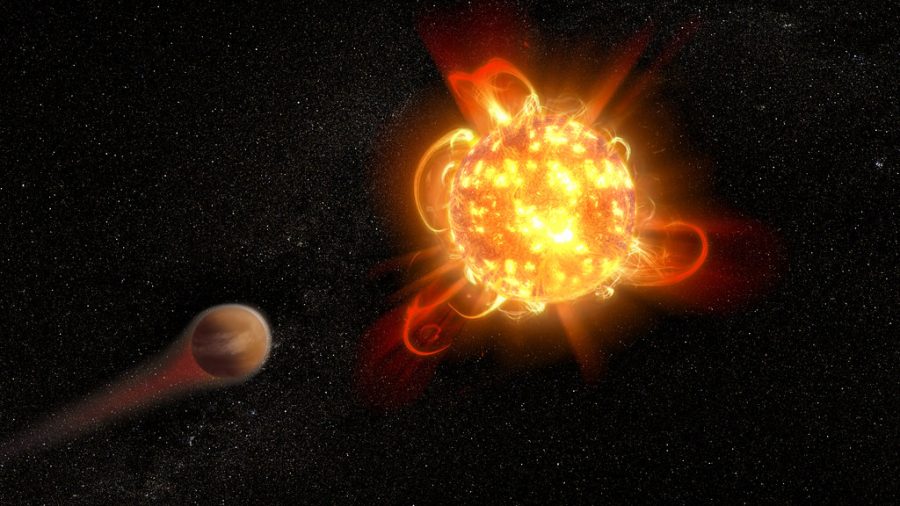E=MC^”Woah” The Return
Stars. There are a lot of them. If you have ever had the chance to look up at night in an area with little light pollution, you can attest to their ubiquitous grandeur across the sky. It may surprise some, though, to know that the quantity of stars is not the only large number value related to these cosmic objects, for there are many TYPES of stars as well. Like breeds of dog, stars can come in all sorts of colors and sizes. According to UniverseToday, there are neutron stars, red giant stars, blue giant stars, variable stars, and binary stars (just to name a few). However, one type of star that I believe does not receive enough love is the dwarf variety of star. Also according to UniverseToday, a dwarf star is a “star that is not a giant or supergiant … in other words, a dwarf star is a normal star!” Yes, they may be viewed as basic, and no, they are not super massive or one of the densest entities in the universe, but dwarf stars still provide many spectacular phenomena to the cosmos. Additionally, there are so many types! From blue dwarfs, to red dwarfs, to even black dwarfs, whatever your personality, a dwarf star will be just right for you! But as I continued to fanboy over these celestial objects, a question arose in my mind: Which one is the best? Now, I realize I just finished preaching how fabulous every dwarf star was, but if there is one thing we humans like, it is a competition. That is why, for the second installment of E=MC^”Woah,” we are going to have a little fun, and commence the first ever DWARVEN STAR FACE OFF!
Alright, so the rules are simple. The most prominent dwarf star species- brown dwarf, white dwarf, red dwarf, yellow dwarf, black dwarf, and orange dwarf- will go head to head in a contest to see which one truly shines the brightest. Contestants will be judged on defining attributes of said star, may it be size, hottness, or another property. The judge of the competition will be myself, and if you have any problems with my rankings, go write your own space article. Alright, rules make sense? Good. Lets Begin:
6. In last place we find the red dwarf. Coming in at a solid median value of 2650 degrees Celsius, this star seems to be no laughing matter. However, when one compares it to its peers, some glaring flaws come through. First off, out of the dwarfs, the red dwarf is the second smallest, with a median radius of around 0.41 the size of our sun (star size is measured compared to our sun). In addition, they have barely enough heat to proceed with the nuclear fusions all stars need to survive. The only property of this star that makes it stand out is its insane lifespan, maxing out at around 5500 BILLION years. Because of this, the red dwarf is the most common star, but sadly, this is not enough to get it higher on the list.
5. Now, the only thing I could think of worse than barely being a star is not being a star at all, and this is the case with brown dwarfs. However, the reason that these stars are higher on the list than red dwarfs is the fact that they even exist in the first place. Known as “failed stars,” brown dwarfs are a collection of cosmic gas that does not have the density nor the heat to officially become a star. They are even smaller than a red dwarf (median stellar radius of 0.08), sometimes only being somewhat larger than the largest planet in our solar system, and only exist at a max of 1800 degrees Celsius. But again, the reason that they are this high on the list is because of the phenomena behind them. These almost-stars are persistent, and I respect that (also this is kind of a pity ranking).
4. At number 4 we find the yellow dwarf. Being the biggest of the dwarfs with a maximum solar radius of 5.0, putting this star any lower would not have been right. Additionally, yellow dwarfs do have some impressive stats. With a max outside temperature of 7300 degrees Celsius and a lifetime of at most 17 billion years, this star is respectable. Additionally, our sun is technically classified as a yellow dwarf, so basically, this star is the only reason this article even exists right now.
3. Next up is the orange dwarf, and what makes this star so special is not its amazing lifespan or massive size, but its ability to sustain life. This star does not produce any life exterminating solar flares at a whim such as red dwarfs and actually lives much longer than yellow dwarfs by around 56 billion years. Additionally, the article “Orange Stars are Just Right for Life” explains that orange dwarfs are relatively stable throughout their existence, which means no sudden change in temperature for surrounding planets. Essentially, if we ever choose to colonize outside of our solar system, an orange dwarf would be the best option.
2. Okay, down to the top 2. Whatever these stars have must be pretty special to be placed so high. Well, ironically, what the thing that makes this dwarf so special is what is does not have. If the black dwarf had a favorite holiday, it would be Halloween. The remnants of a cooled white dwarf (an already dead star), the black dwarf is pretty much “death-seption.” As white dwarf stars take obscenely long periods of time to cool (sometimes up to 10^25 billion years), no black dwarfs had actually had the chance to form yet. However, PhD holder Dr. Thomas Swan states that said “stars” would probably exist at temperatures of -270 degrees Celsius and below. Basically, black dwarfs are too unique and special to be any lower on the list.
1. And that brings us to the number one spot in my cosmic contest. Now, if you have utilized the very useful process of elimination, you have deduced what the winner of the competition is. In my humble opinion, the white dwarf is the most unique out of all the stars. In a total disregard for death and the laws of nature, the white dwarf bursts forth from the corpse of a dying star. Okay, in reality the dwarf forms when a dying star shrinks to a core the size of our planet, but the former sounds cooler. In this state, the dead star displays qualities well beyond what was possible in the realm of “living dwarfs.” You thought the red dwarf lived long with its 5500 billion years? Child’s play, as according to the aforementioned Dr. Swan, white dwarfs can live for a maximum of 10^25 billion years. That is a 10 with 25 zeros! If you still cannot imagine it, let me type it out for you:10000000000000000000000000 years. That is how long this star lives! If you believed the yellow dwarfs 7300 degree Celsius surface heat was impressive, how about a high of 150000 degrees Celsius? Also most stars are predicted to become white dwarfs, so essentially, this number one spot goes to every member on the list (except brown and black dwarfs, sorry guys). Essentially, the white dwarf is the top dog in the cosmic kennel that is space.
Well, there you have it: my list of the top dwarf stars. I hope you found this article a nice combination of fun and informative (or in-fun-ative), and that you will check back next month for another issue of E=MC^”Woah!”
Here is a list of all of the sources that I used to gather this whelm of information. Credit to these amazing sites which I definitely encourage to check out!
https://www.universetoday.com/46729/dwarf-star/
https://www.universetoday.com/24299/types-of-stars/
https://www.physicsoftheuniverse.com/what-different-types-of-stars-are-there.html
http://www.astronomytrek.com/list-of-different-star-types/
https://owlcation.com/stem/Different-Types-of-Stars-in-the-Universe
https://www.newscientist.com/article/dn17084-orange-stars-are-just-right-for-life/

Lucca is a 3rd year Crimsonian member. He is involved in theater, orchestra, tennis, and National Honors Society.






